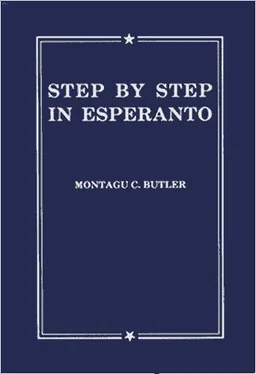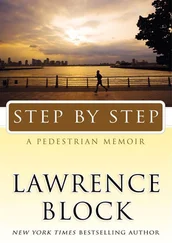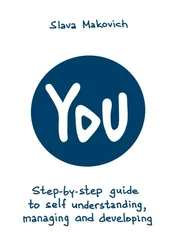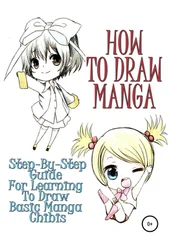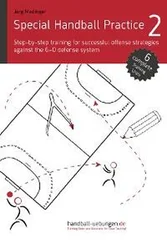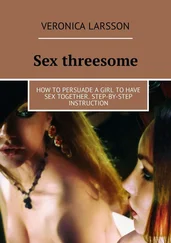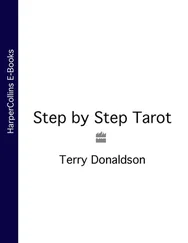In order to accustom the learner to use the nominative after a preposition, the accusative has been introduced very late. Opinions will differ as to the wisdom of this. For conversation, at any rate, the accusative is almost indispensable. Introduce it as early as you think desirable.
For class conversation, a few useful words and phrases (e.g., lernejo, Bonan Tagon! ) are introduced prematurely. They should be learned without explanation: this is given later in due course.
ROOTS. An effort has been made to build up a useful vocabulary. In the first few pages new roots have been introduced freely, for exercise in pronunciation; but as they are English, and safely guessable, this will not strain the memory. Point out, however, that Esperanto does not simply add an “o” to every English word! Pigo= magpie (not pig ); porko= pig (not pork ); lardo= bacon (not lard ).
ETYMOLOGY. After the first few pages, new roots are shown by bolder type on their first appearance. When an unfamiliar root occurs, point out when possible — and it usually is — that it exists also in English, and that a knowledge of Esperanto thus helps to understand English. E.g., molais found in emollient, mollify; saltiin somersault ; panoin pantry, companion ; sortoin consort.
Many Esperanto roots are etymologically related. Explain, for example, the connection between aŭskult, skolt,and scout; apenaŭ, pen,and pains ; lum, lun, ilumin, alumet, lunatik,and lund.Such notes are omitted to save space.
MNEMONICS. No apology is made for “childish mnemonics”. To distinguish muŝoand musoby imagining that the circumflex represents the wings of a fly, or dezertoand desertoby picturing a zebro en la dezerto; to remember that abelofaras mielonby the exclamation A bee, lo! and the thought “If a bee drops pollen on me it makes me yellow ; if it stings me it makes me yell ‘Oh!’” — such things often stick when serious explanations leave no impression.
WORD-BUILDING EXERCISES. These give practice on affixes already learned. The student should form similar combinations for himself. The fact that there is often no one corresponding word in English makes them especially valuable as tests. The classmember who has not mastered the previous lessons will of course protest!
READING MATTER. This is taken from many sources, sometimes altered for the purposes of the book. The verses are mostly taken from Himnaro Esperanta and Kantaro Esperanta (which contain hundreds of songs suitable for class singing). The humorous “definitions”, by his kind permission, are from Cseh’s Konversacia Vortaro.
When some progress has been made, you can (if you wish) supplement this book with other reading matter. But to do this prematurely will raise difficulties. You would be wise to concentrate first on the book, which itself contains sufficient reading for the stage reached.
ANECDOTES. These the pupil may repeat in his own words. They should be a basis for simple conversation. Some may be expanded into impromptu playlets, and acted.
PROVERBS. These are nearly all from Zamenhof’s Proverbaro Esperanta. Some require a little thought, but none are more difficult than similar proverbs in English. A few elucidatory equivalents in English verse have been added as footnotes. Some proverbs should be learned by heart. All will repay study. Often a proverb will be more easily remembered than the rule it illustrates.
PARAGRAPHS MARKED **. Give some of these vive voce, accompanied by appropriate action. They may be repeated also with variations of tense or circumstance. Write the verbs (or other suggestive words) on the blackboard, and let the class repeat the whole from memory.
QUESTIONS. These should be asked and answered in class conversation, and used as models for other similar questions. Do not accept Jesor Nealone as an answer. Let most questions begin with a Ki-word, rather than with Ĉu.
EXERCISES are intended to be worked. No key is given, for this would rule them out as homework. Most exercises may be worked orally in the class. But some written work is essential. Exercises in italics are to be translated into Esperanto. Easy Esperanto texts need not be translated into English.
At regular intervals (say every 15 pages) give a recapitulation exercise. Paragraphs 12, 43c, 51, show the idea.
DICTIONARIES. The student should have an Esperanto-English dictionary. The little “Key” will suffice at first. Larger dictionaries are available for the advanced student.
A SUMMARY OF THE GRAMMARis given at the end of the book for reference.
STEP BY STEP IN ESPERANTO
1. Every letter in Esperanto has one sound only, always the same. Every letter must be sounded: there are no silent letters. Most letters sound as in English. Those that do not we shall learn as we meet them.
2. In English each of the letters a, e, i, o, u, represents several sounds, but in Esperanto each represents one sound only, approximately as follows:
Aalways sounds like a in ah, f ather, c alm.
Ealways sounds like e in l end, th ere.
Ialways sounds like i in mach ine, ee in s ee .
Oalways sounds like o in m olest, gl ory.
Ualways sounds like u in r ude, oo in b oot, t oo.
Do NOT pronounce aas in what, cat, cake or call; eas in her or here ; ias in fine or fir; oas in to or got ; or uas in tub, tube or turn .
These five letters are called “vowels”. All others are called “consonants”. We may say, roughly:
Vowels: A, E, I, O, U,
Sound in Pa, let me go too.
Or in Bar, bear, bier, bore, boor.
Ah! send me more soon!
3. Point to the vowels and say them aloud several times; forward, backward, and in varied order; till you know them without hesitation.
4. In English we accent (or stress) sometimes the last syllable ( cocka too ), sometimes the last but one ( to mato ), sometimes a syllable two or more from the end ( syllable, dromedary, literature ). In Esperanto every vowel counts as one syllable, and every word is accented on the last syllable but one. Thus: ka-ka- tu-o, to- ma-to, si- la-bo, dro-me- da-ro, li-te-ra- tu-ro. The words historio( history ) and harmonio( harmony ) have therefore four syllables each, and you must accent the iin io.
Читать дальше
